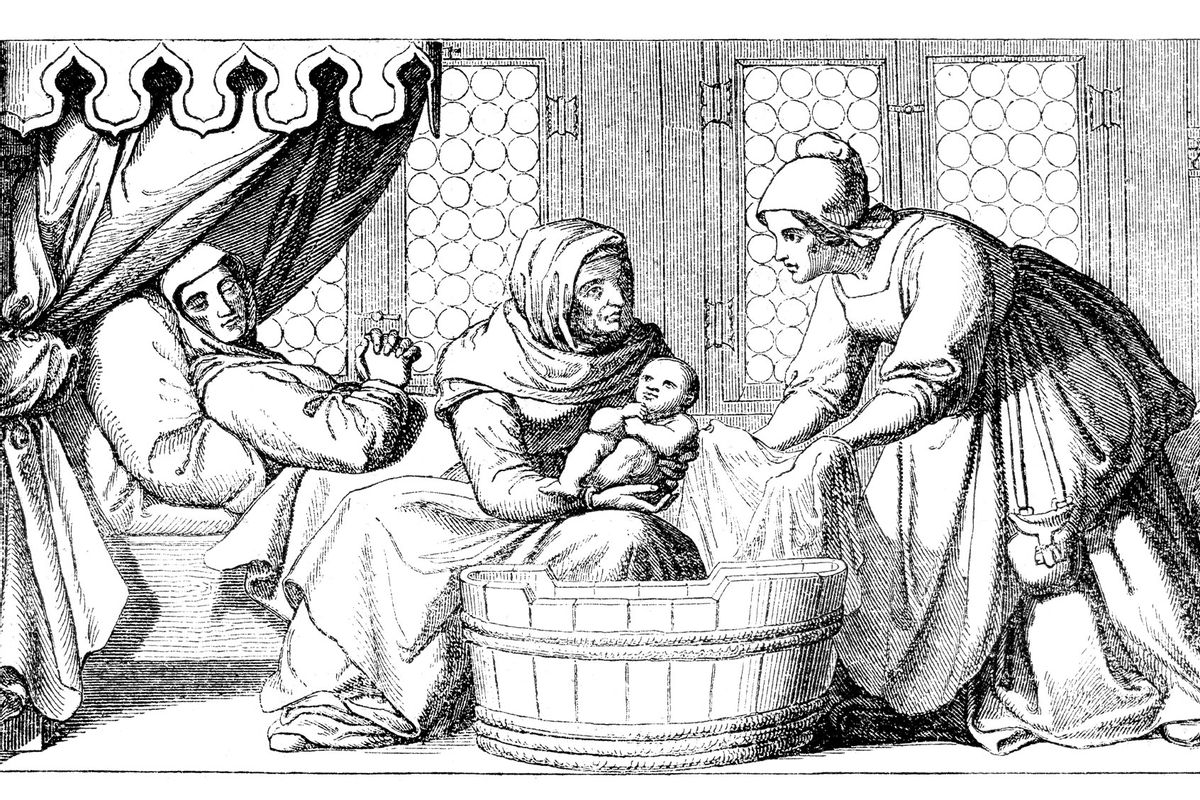Were midwives the OG witches? How the history of mystic medicine and reproductive health intertwine

There is a unique power contained in a room where a woman is giving birth. There is power in the women surrounding her. It’s a time of transformation, an alchemy unlike any other. No wonder, in so many places in the world, that power would be regarded as suspicious. Midwives and witches — they’ve always had a lot in common.
The line between the physical and the spiritual has always been permeable. As Liese Sherwood-Fabre, PhD, a novelist with over than thirty years in the area of family planning, explains it, in ancient eras, “Pregnancy had a magical aspect to it. Equating the birth of a child to an act that had occurred nine months prior was not intuitive.”
A current exhibition at Edinburgh’s Surgeons’ Hall Museums that explores “The Battle for Midwifery” unpacks the legacies of that engimatic relationship. “Until the 18th century childbirth was a community-focused social and ritualistic event,” curator Louise Wilkie writes on the museum’s blog, “with the management of births controlled by women and the lying-in chamber a female-only space. Part of a traditional midwife’s role was adherence to superstitions, and she was perceived to be particularly skilled in halting exchanges with evil spirits.” Which could, in certain circumstances, make her vulnerable to accusations of being in consort with them.
It’s been fifty years since Barbara Ehrenreich and Deirdre English first connected the dots in their book “Witches, Midwives, and Nurses: A History of Women Healers.” In it, they charted the marginalization of women from their own reproductive care. “If a woman dare to cure without having studied,” they wrote, “she is a witch and must die.” To the authors, it was unsurprising that the European and colonial Witchcraft Acts of the 16th and 17th centuries overwhelmingly targeted females. Over 80% of the victims arrested, tortured and executed were women, a “gynocide” that they posited was centered on “control of the healing arts.”
Those healing arts encompassed a variety of reproductive concerns. “The same women who would have assisted in childbirth would have also been consulted regarding ways to avoid pregnancy,” says Liese Sherwood-Fabre. “Most of these women were illiterate, so they didn’t leave written records of their practices, but would have handed down their remedies to their apprentices. Apothecaries, pharmacists and botanists, however, identified a number of herbs and plants that were known to cause a miscarriage (noted as causing a woman to bleed or for pregnant women not to touch).”
“Part of a traditional midwife’s role was adherence to superstitions, and she was perceived to be particularly skilled in halting exchanges with evil spirits.”
She continues, “Other plants were known to have contraceptive or spermicidal effects. These were certainly part of a midwife’s provisions. Such treatments often required the woman (or man) to recite prayers or other words while using the herbs to ensure their effectiveness. Less effective, but common, practices also included wearing amulets around the neck or arm to avoid pregnancy.”
Ritual and incantation, along with the use of herbal remedies, have long been pervasive across all aspects of healthcare. A 2011 paper in the journal Social History of Medicine notes that in the middle ages, “many recipes mingle ‘charms and magic’ with pharmaceutical preparations.” But until the 19th century, women’s healthcare “was considered women’s business,” says Waltraud Maierhofer, PhD, a professor of German and Global Health Studies at the University of Iowa, “especially abortion.”
That hands-off approach offered women a certain level of gynecological trust and freedom around their reproductive health. But then, Maierhofer says, “The major change came with the professionalization of medicine and also the spread of universities.”
The era also ushered in a conservative-leaning shift in religious ideologies, with a new distrust of women’s management of their “courses” and a renewed evangelical disdain for what the International Museum of Surgical Science notes as “ameliorating the pain of delivery” (aka Eve’s curse). Women soon found themselves excluded from the childbirth process, and abortion going underground. That shift “changed the whole view of what was considered abortion,” says Maierhofer, “what was criminal and what was just what women did without anybody else caring about it. Men took on childbirth and women’s health in general.” The female midwife all but disappeared.
Midwifery is deeply rooted in the mystical, and women demonstrating competence in their own care is always regarded as troublesome. But historically, your friendly neighborhood midwife was not a surefire candidate to be singled out as a witch by her clientele.
Midwifery is deeply rooted in the mystical, and women demonstrating competence in their own care is always regarded as troublesome.
Over a nearly 200 year period in Scotland alone, roughly 4,000 individuals were accused of witchcraft. Yet digging into the archives in 2021, Professor Nicola Ring of Edinburgh Napier University discovered just 142 cases where crimes of witchcraft were “related to their healing or midwifery practices.” And only 19 were explicitly identified for midwifery, like Agnes Sampsoune, “one of Scotland’s best-known witches” and “a renowned midwife.”
Writing back in 1990, historian David Harley disputed the notion that midwives were singled out for persecution, asserting that “In few of the vast numbers of trials were midwives accused … A few spectacular cases have been mistaken for a general pattern.” Harley’s skepticism in light of surviving evidence is worth acknowledging, though it’s worth investigating how members of a community might have identified themselves in any era, and how encompassing women’s work has always been.
Want more health and science stories in your inbox? Subscribe to Salon’s weekly newsletter Lab Notes.
A comprehensive, decade-long 2023 study on “Work, Gender and Witchcraft in Early Modern England” out of Cambridge University appears to bear out that women who worked in healing, childcare (including wet nurses) and other female-centric professions were indeed often more vulnerable to accusations of witchcraft. While reputable midwives might “usually” be safe, “Less reputable, more disposable healthcare workers were not.”
What drove female practitioners out of obstetrics was far more the common, everyday machinations of the patriarchy rather than religious superstition. Today, midwifery, along with other less medicalized practices like home births, is gaining ground in the United States, albeit incrementally. Midwives now attend roughly 12% of births in this country. And over 32% of all births are by Cesarean. What’s undeniable — and fascinating — is that our modern practice of obstetrics is so sterile, medicalized and frankly masculine that the closest analogue we have for older, more feminine methods is witchcraft. You picture a woman who perhaps prescribes herbal remedies and performs reassuring rituals related to a pregnant woman and her fetus, likely in her own home, who knows her and recognizes her pains. Sounds like a witch.
Read more
about midwives and women’s health


